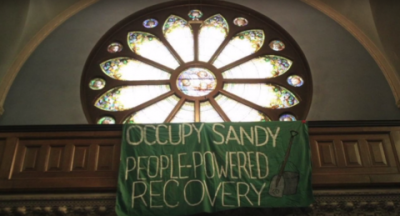
Sal Lopizzo, a longtime resident of New York City, became involved with the Occupy Sandy recovery effort when a group of volunteers showed up at his flooded nonprofit and asked if they could convert it into a recovery hub. "People just showed up, gutted the office out, got everything out into the street," Lopizzo says. "We started putting up tables, trucks just started showing up with supplies. Any supply you could think of. If you walked into Home Depot or into a Target store, it was in this office."
Lopizzo's building was just one of many hubs that emerged in the days and weeks after the Superstorm hit. It was fed by a dozen or more distribution hubs, which were located in areas that were not as heavily affected.
"There were churches in Brooklyn that were gathering supplies to put on vans and trucks and bringing them in here," he says. "One time I saw a Greek Orthodox priest pull up in a minivan with a bunch of kids, and they had about one hundred pizzas. And he just showed up here, you know. I was like, 'Holy mackerel' — it was amazing."
Go to the GEO front page

Add new comment